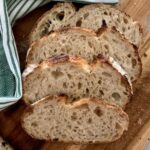
High Altitude Sourdough Bread Recipe
This simple, tasty sourdough bread recipe has been adjusted to accomodate higher altitude elements. It will allow you to bake successful sourdough at higher elevations.
Servings 1 Loaf
Calories 1851kcal
Equipment
- Mixing Bowl
- Digital Scales
- Banneton
- Dutch Oven
Ingredients
- 500 g Bread Flour
- 400 g Water (only add 350g to start with)
- 25 g Sourdough Starter (fed and bubbly) you can increase or decrease further as you see fit (see notes)
- 10 g Salt (increase or decrease according to your taste)
Instructions
- Autolyse - Premixing The DoughWeigh out your sourdough starter and 350g water into a large ceramic or glass bowl. Remember to only use 350g for the first part, you can add more after autolyse has finished if the dough is too dry.Mix the water and starter together briefly. Then add your flour and salt and mix whole lot together to form a shaggy dough. I find a dough scraper the easiest way to mix it as you can keep the sides of bowl clean.The dough will be fairly shaggy and only just brought together (see photo). You might wonder how this will turn into bread, but just wait, time is your friend and the dough will change in around an hour.
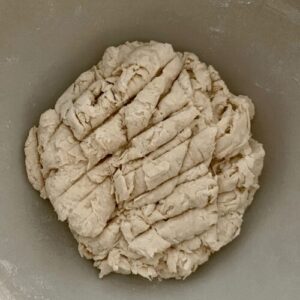
- Cover your bowl with cling film or a damp tea towel and let it sit for around 30 minutes (up to one hour is ok).This process is called the "autolyse" and allows your flour to soak in all the water and become hydrated. You can see how the dough has changed in this photo.
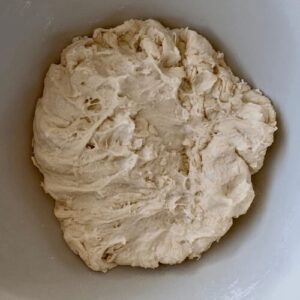
- High Elevation Tip - Increase the Hydration if NecessaryCheck the feel of your dough. If the flour was absorbed all the water and is still dry, add half the extra water and see how it feels. You can add up to 50g extra water if necessary.
- Forming Up The DoughAfter the dough has been through autolyse you need to bring it together into a ball. Work your way around the bowl, grabbing the dough from the outside, stretching it up and over itself, into the centre, until a smooth ball is formed. You shouldn't need more than about 20-25 stretches to form the ball.You'll notice that the dough is fully hydrated after soaking all the water up. It will be fairly sticky but as you bring it into a ball, it will become smoother and shinier.
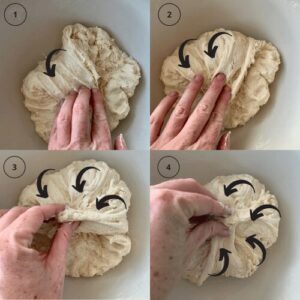
- Once the dough has formed into a smooth ball, pop the cling film back on and let it rest for 30 minutes. It's really important to keep the dough covered at high altitude to ensure that you don't lose any moisture.
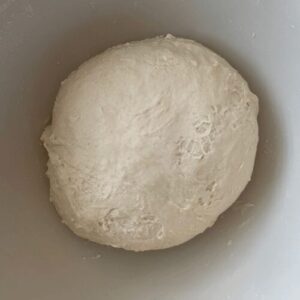
- Stretch & Fold - Strengthening GlutenOver the next few hours you need to create some structure for your dough by "stretching and folding". Aim to do around 6 sets of stretches and folds. For each set, stretch the dough up and over itself 4 times. Leave around 15 minutes in between each set. Again you do not have to be exact with time, but you need to do at least 6 sets over 2 hours.
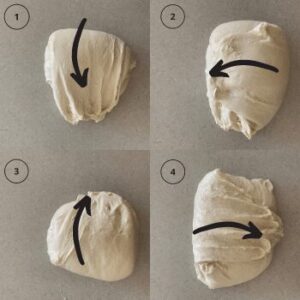
- Bulk FermentOnce you've finished your stretch and folds, place the cling film back over your dough and let it rest and ferment (a plastic cover is a better option for this stage).Remember that you need to watch the bulk ferment carefully at high altitude as it will happen faster. You're looking for the dough to double, but this will happen faster than you think.
- Shaping The DoughOnce your dough has finished it's first ferment, it's time to shape it into either a boule or a batard. It's better if you don't use any flour for shaping as this will dry the dough out - and you want to avoid this at high altitudes.Use a silicone dough scraper to gently ease the dough out of the bowl. You want it to land upside down on your counter so that the smooth top of the dough is on the countertop and the sticky underside is facing up. This will make it easier to shape.You want to pull the edges of the dough into the centre and then flip it over so that the sticky side is now underneath. Using the stickiness, gently pull the dough into a tight ball.You will need a banneton to put your dough into. If you do not have a banneton, then a bowl or basket lined with a floured tea towel is perfectly fine. Make sure your bowl isn't too big though, you want your dough to retain some shape.Whatever you're using needs to be liberally floured with your rice flour. If you're using a banneton - liberally sprinkle it with rice flour. If you're using a cloth or tea towel, rub the flour into it to ensure it becomes non stick.
- Placing Into A BannetonOnce the dough is shaped into a tight ball, place it into your banneton smooth side down, so your seam is on the top - this way the top of your dough will get the pretty lines from the banneton. If you're using a cloth or tea towel in a bowl it's ok to put your dough with the smooth side up. Just make sure the dough is tight.Make sure you place a plastic cover over the banneton to stop the dough from forming a dry skin.
- Cold FermentNow the dough is in its "shaping container" cover it loosely with a plastic bag and place into the fridge. Try to leave it in the fridge for a minimum 5 hours up to a maximum of around 12 hours. A shorter cold ferment is better in higher altitudes as it has less chance of over proofing.
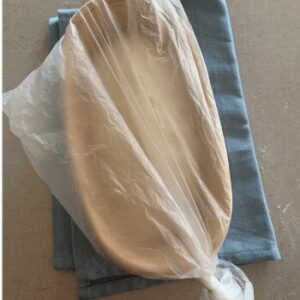
- Preparing To BakeOnce you're ready to bake your sourdough, you'll need to preheat your oven to 260C/500F. Place your Dutch Oven into the oven when you turn it on so it gets hot. Try to preheat for around 1 hour to ensure your oven is super hot - but you know your oven so just adjust this time if you need to.Leave your dough in the fridge until the very last minute - placing a cold dough into a hot oven will give you a great "spring".This oven temperature is higher than I would normally bake sourdough - it has been adjusted for higher altitudes.
- Bake Time!Now it's time to bake!When your oven is at temperature, take your sourdough out of the fridge. Gently place it onto a piece of baking paper. Make sure that you make the baking paper big enough to use the edges as a handle to lower to dough into your Dutch Oven.Gently score your bread with a lame, clean razor blade or knife. At minimum a large cross is sufficient, but you can get as artistic as you like. Try to score it fairly deep to ensure the dough opens up.Carefully take your dutch oven out of the oven. Place the sourdough into the pot using the baking paper as a handle. Put the lid on and place into the hot oven. If you want to you can spritz your dough with extra water before you put the lid on.BAKE TIME:30 Minutes with the lid on at 260C/500F plus10-15 Minutes with the lid off at 240C/464FRemember that longer baking times may be needed at higher altitude, so if your bread does not look or feel done, you can leave it in the oven for up to 15 minutes longer.
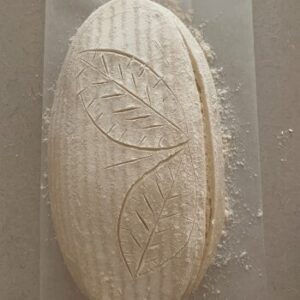
- Finishing The BakeWhen you remove your dough from the oven, carefully remove it from the dutch oven as soon as possible and place on a wire rack to cool.
Notes
Please note this recipe is based on my original "Simple Sourdough Recipe" and has been adjusted to accomodate higher altitude elements. You may still have to make further adjustments to suit your unique environment and particular elevation.
- Notes on Flour: This recipe is written using strong Bread Flour. Bread flour has a higher protein content than All Purpose flour. If you choose to use All Purpose flour you may have a different result because of this. You can read more on this here.
- Notes on Sourdough Starter: This recipe is based on you having an active starter that you have fed a few hours before starting your bake. For information on whether your starter is ready, go here. The amount of starter has been decreased to 25g (from 50g) to accomodate higher altitudes. You can increase it back to 50g if you want to - see notes in the article above for more information.
- Notes on Stretch & Folds: If you are going to do the stretch & folds on your bench top, spray your surface with water mist rather than using flour. You can leave the dough in the bowl if you want to. Wet your hands to stop the dough sticking - although it shouldn't be too sticky. It will get less sticky as you do your stretches and folds.
Nutrition
Calories: 1851kcal | Carbohydrates: 372g | Protein: 61g | Fat: 8g | Saturated Fat: 1g | Sodium: 3904mg | Potassium: 501mg | Fiber: 12g | Sugar: 2g | Vitamin A: 10IU | Calcium: 88mg | Iron: 5mg